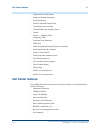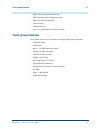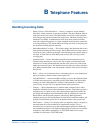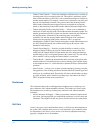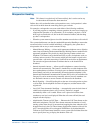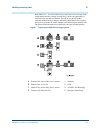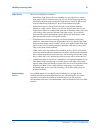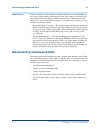
109
Overview for Avaya IP600 Internet Protocol Communications Server
555-233-001 — Issue 5 — November 2000
B Telephone Features
Handling Incoming Calls
• Station Used as a Virtual Extension — Allows a customer to assign multiple,
individual, virtual extensions to one physical phone. The physical phone must be
analog and on the local switch. The administrator can set each virtual extension
with a unique ring pattern to identify the extension for which the incoming call is
intended. For example, an administrator could assign three virtual extensions,
each with a unique ring pattern, to a single telephone shared by three roommates
in a college dormitory. This feature affects incoming calls only; all outgoing calls
are associated with the physical extension.
• Station Hunt Before Coverage — This feature changes the interaction that occurs
between station hunting and call coverage. Station Hunt before Coverage causes a
call going to a busy station to go through a station hunting process before going to
coverage. If all the stations in the Hunt group are busy, the call will go to the
coverage path.
• Automatic Hold — Allows Attendants and multi-function telephone users to
alternate easily between two or more calls. For example, with automatic hold,
selection of a second call automatically puts the active call (if any) on hold and
makes the second call active. This feature can be activated on a system-wide basis
only. When automatic hold is not activated, the selection of the second call drops
the first call.
• Hold — Allows you to disconnect from a call temporarily, use your telephone for
other call purposes, and then return to the original call.
• Long Hold Recall — Visual and audible warnings are sent to the telephone where
a call has been on hold past a specified period of time. Both visual and audible
warnings are used if the telephone is on-hook. If the telephone is off-hook, a
“priority ring” is used. This is an optional feature at the system level.
• Transfer — Allows telephone users to transfer trunk or internal calls to other
telephones within the system without attendant assistance. This feature provides a
convenient way to connect a party with someone better qualified to handle the
call. Single-line telephone users momentarily flash the switchhook or press the
Recall button, dial the desired extension, and hang up. Multi-appearance
telephone users press the Transfer button, dial the desired extension number, and
press the Transfer button again. This is an optional feature at the system level.
• Pull Transfer — Allows either the party who was originally called or the party to
whom the held call will be transferred to complete the transfer. This is a
convenient way to connect a party with someone better qualified to handle the
call. Attendant assistance is not required and the call does not have to be redialed.
It interfaces with satellite workstations via TGU/TGE trunks and is always
available for calls that use TGU/TGE trunks.






